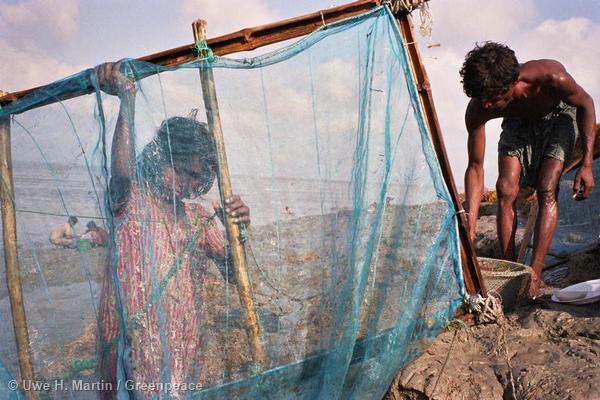The Bangladesh government has said it will give top priority to the US$4 billion Ganga Barrage Project, to expand irrigation and reduce salinity levels in the country’s south-west coastal region.
The project, welcomed by experts as an initiative that will transform the region but crippled by lack of funds, will come up at Pangsha in Rajbari district, 98 kilometres downstream from the Farakka barrage built on the Ganga in the Indian state of West Bengal.
“The government has given top priority to implementing the proposed Ganges Barrage Project. If the proposed barrage project is implemented, salinity and arsenic problems and water scarcity will be addressed in the south-western region of Bangladesh,” said Water Resources Minister Anisul Islam Mahmud.
“Agricultural production will increase in the region…Its people will benefit both economically and environmentally,” the minister added.
According to the feasibility study, an estimated Tk 31,414 crore (about US$4 billion) is needed to implement the project over seven years. However, the government is yet to mobilise the funds.
Bangladesh’s south-west region, home to one-third of the country’s 158 million population, is dependent on the Ganga.
The river, known as the Padma in Bangladesh, is the only source of surface water in the region. Experts agree that a barrage is urgently needed to manage dwindling water resources and boost economic growth of the area.
In 1975, India constructed the Farakka barrage across the river that flows through both countries to divert 40,000 cusecs of water into the Bhagirathi-Hooghly river in West Bengal to flush out sediment deposits from Kolkata harbour.
This has dramatically reduced the flow of the Ganga, affecting agriculture, fishery, forestry, navigation, domestic water supply and industrial development in Bangladesh.
The world’s largest mangrove forest, Sundarbans, is now under threat from rising salinity caused by lack of water flow during the dry season. A recent study by the Bangladesh Centre for Advanced Studies (BCAS) showed salinity levels in rivers and coastal regions had doubled in the first decade of this century.
Project details
According to official sources, the proposed barrage will create a reservoir, covering 62,500 acres, with a capacity of about 2,900 million cubic litres of water. The reserved water will be diverted to 26 districts through regional rivers in the south-west area. In addition, a 100 MW hydropower plant will also be built on the barrage.
Once the barrage is built, the Ganga reservoir water will be distributed through a network of channels in the dry season to meet the water demands for irrigation, fisheries, navigation and salinity control, said Rowshan Ali Khan, acting project director.
The release of water from the reservoir through the river system of the Ganga dependent area will help manage siltation problems in river channels and preserve biodiversity and forest resources in the Sundarbans, he added.
Eminent environmental expert and executive director of Bangladesh Centre for Advanced Studies (BCAS) Atiq Rahman, also welcomed the project but sounded a note of caution. “This is a long-standing project, which was discussed in last several years. The proposed Ganges Barrage Project does need rigorous environmental, social and climate impact assessments.”
He said alternative options for overcoming water scarcity must be looked into.
India’s cooperation key
The pivotal question is how to ensure adequate water flow along the trans-boundary Ganga to keep the project operational. If India does not release adequate water of the river upstream, the project will fall flat like the Teesta barrage – which did not benefit Bangladesh because India unilaterally withdraws water from the river. Farmers now face trouble during the dry season due to lack of water flow.
However, Water Resources Minister Mahmud said this should not be a problem. The Ganges Water Treaty signed between Bangladesh and India in 1996, guarantees Bangladesh an equal share of the downriver flows during the difficult dry season.
“The treaty will be renewed. As per international convention, upper countries cannot take such projects on common rivers that affect the lower riparian countries,” he added.
Counting the benefits
Most experts believe the Ganga project will boost socioeconomic development of Bangladesh.
According to water expert Ainun Nishat, the project should be implemented as soon as possible to increase river flow and protect the southwest region, including the Sundarbans, from salinity intrusion.
According to project officials, the project will bring economic benefits of Tk 7,340 crore (US$900 million) every year, which means the cost will be returned within five years.
The project will boost agricultural production in the Ganga dependent area –an additional 26 lakh metric tonnes of paddy production and 2.4 lakh metric tonnes of fish production.
Sarfaraz Wahed, director of water resources at the Dhaka-based Center for Environmental and Geographic Information Services (CEGIS), said the project will improve navigation upstream of the barrage up to Pankha and along the Gorai river to Mongla seaport.
Not everyone agrees the barrage is the best solution. “Bangladesh can get short-term benefits from the project by dredging the rivers of the country’s southwestern region, but it will ultimately cause damage to the Padma river,” said Abdul Matin, general secretary of Bangladesh Paribesh Andolon (Bapa), a civil society environmental organisation
Bridging the funding gaps
Though the Awami League-led government tried to start implementation of the project in its last tenure, funding continues to be a problem. The project has in fact been under discussion since the 1960s, but has failed to attract interest from foreign funders.
In July 2013, the Bangladesh Water Development Board (BWDB) signed a memorandum of understanding (MoU) with Chinese company, Changjiang Survey, Planning, Design and Research (CSPDR), to plan and build the project. Two other Chinese companies — HydroChina and Sinohydro — have also shown interest in financing the project and submitted proposals to the Finance Ministry.
“We’re trying our best to collect funds to implement the projects as possible. When we will be able to mange fund, we will start of the work of the barrage project,” Minister Mahmud said.

